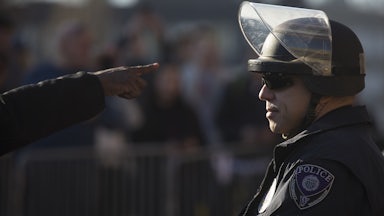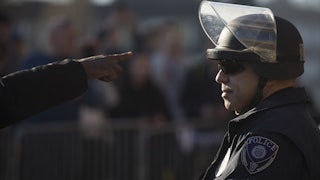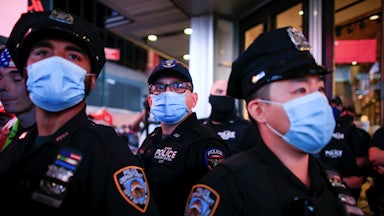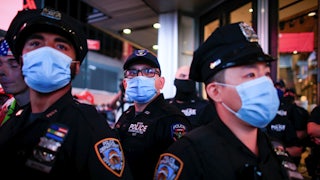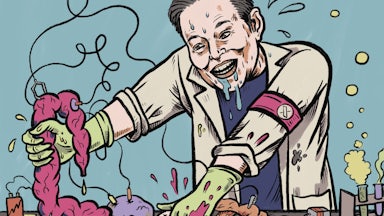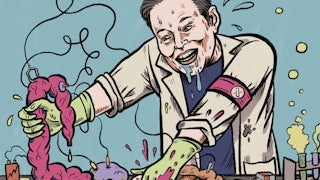Sarah Everard, to hear her story told for her now, was killed “after doing everything she was supposed to do. She took a longer route that was well-lit and populated. She wore bright clothes and shoes she could run in. She checked in with her boyfriend to let him know when she was leaving. But that was not enough to save her life.” Something sinister, yet only gestured at, is responsible, “an epidemic of male violence against us, most of which takes place behind closed doors, often by men already known to the police.” In the case of Everard, the man was known to police because he was the police. How is the name “Wayne Couzens” not in the opening lines of every story about the killing of Sarah Everard and the movement against gender-based violence now gathering in her name?
Couzens is the man charged with kidnapping and murdering Everard in March. He is a London police officer. To not name him and the systems of violence that enable men like Couzens is to do their work for them. It’s as if it was almost acceptable for women to rise up against men who kill women, so long as we didn’t say it was allegedly a cop who did the killing. So when the same police force that employed the accused murderer shut down a vigil and protest for Sarah Everard over the weekend, its abuse of power should have come as no great shock.
What women are protesting is not only male violence—it is police violence. “We gathered at Clapham Common,” reads a statement by the group Sisters Uncut, “because of our grief and anger at the senseless murder of Sarah Everard. We gathered because after Sarah’s disappearance, the police told women that they should stay at home after dark to avoid being attacked.” Police reportedly went door to door after Everard’s disappearance, offering protection in the form of a curfew, which is another way to make women disappear. If that’s the best the law can do, then the law cannot be relied upon to keep women safe. To be safe may also require going outside the law. “[W]e demand the right not only to survive but to thrive. And that means going where we want, when we want,” the Sisters Uncut statement continues. “Many of us know that surviving and thriving means disobeying orders, and that’s why so many of us are here tonight.”
Groups like Sisters Uncut see the links between gender-based violence and police violence; their protest connected the killing of Sarah Everard with a proposed bill expanding police powers, including the power to crack down on protests, currently under consideration in Parliament. A mourning chant at a protest on Sunday, which had kicked off at Scotland Yard, named women killed by police: “Rest in peace to Sarah Everard, to Breonna Taylor, to Shukri Abdi, to Black trans women who have been murdered, to all women, trans people, gender-nonconforming people, and all those killed by police violence.”
This was after police had aggressively arrested women protesting the day before, after police had obstructed gatherings planned in multiple cities. Police claimed it was for women’s own safety during a pandemic. The group that organized those gatherings, Reclaim These Streets, tried to challenge them in court. “We’re protesting against violence against women, and we’re being shut down by the police,” a Reclaim These Streets organizer told The New York Times. “I’m baffled.” Ultimately they, too, asked women to stay at home. Of course, many hundreds did not. One whose arrest photograph spread quickly over social media was quoted as saying she “accidentally went viral,” that she’s “been thrown into the public eye and the only way that I can make this not in vain is to not make it political, not make it against the police or against anyone. It literally is just about the safety of women.” Despite all this, including that photo of the flame-red-haired woman pressed to the ground by Met officers, some are calling for tougher laws against gender-based violence in response to the murder of Sarah Everard. Those who oppose enhanced state power on the grounds that such laws do not protect women are being told they are not doing enough to protect women themselves.
Let’s be very clear about these events: Sarah Everard is found dead. A police officer is charged with murdering her. Women organize to get out in the streets in Everard’s name. Police try to shut the women down. Women turn out anyway. Officers brutalize some of the women. But what we’re supposed to believe the alleged murder of Sarah Everard is about is women at risk and “male violence,” reduced to something almost essential, devoid of specificity or context or politics. We’re supposed to accept that the solution is that police need more power in order to protect women from this “male violence.”
To try to look at these as distinct problems—male violence and police violence—lets police evade culpability, even as they meet women protesting violence with violence. It assists members of law enforcement in perpetuating this evasion, as former detective superintendent of Scotland Yard Shabnam Chaudhri attempted, when she said, “This wasn’t Black Lives Matter, this is a sensitive issue, where a woman has been murdered, tragically, and it’s raised the alarm and it’s ignited a movement from thousands and thousands of women across the globe.” (A clip of this was circulated and criticized on Twitter, after which Chaudhri responded, “I am sorry, the point I was trying to make was not articulated well, on reflection I shouldn’t have made the comparison I am well aware of the importance of the BLM, for that I apologise.”)
She could have been describing the movement that grew after the death of Breonna Taylor, who police killed in a raid on her home in Louisville, Kentucky, exactly one year before the protests for Sarah Everard. While lawmakers in London consider a bill expanding police powers to shut down protests, Kentucky legislators are advancing a bill that would criminalize protests by enhancing penalties, and which would also make it a misdemeanor if someone “accosts, insults, taunts, or challenges a law enforcement officer with offensive or derisive words, or by gestures or other physical contact, that would have a direct tendency to provoke a violent response from the perspective of a reasonable and prudent person.” After a year of protests and demands for police killings to end, it is a retaliatory move, as was the crackdown in London last weekend.
By splitting “police violence” off from “male violence,” you will get claims like the one made by the former Scotland Yard detective that Black Lives Matter, a movement against police violence and in defense of Black lives, is not also a movement against violence against women. This frame acts as if police committing this violence are not also often “men” and as if the “women” in “violence against women” cannot be Black. Such misogynistic, racist excuse-making in reaction to police violence against women protesters is also a threat: If women protest “male violence,” maybe we’ll protect you; if you protest police violence, we will not only withhold that protection, but if we are violent toward you, we will tell the public you had it coming. It’s a threat that, in this case, was also made by a woman, while a woman is currently the commissioner of the Metropolitan Police, and now is facing pressure to resign.
Consider the outpouring of stories about street harassment—and all the semi-useless things women are expected to do when out walking alone at night; the ensuing appeals to place the burden for keeping women safe on men. “To those who insist on seeing Everard’s death exclusively through the lens of a gender war, I want to say: fear and rage can be an entry point into the rejection of violence against women but not the termination or sum of our collaborations,” wrote Charlotte Shane. “We’ll find no empowerment in petitioning for the protection or mercy of men, neither of which we have a good track record of procuring anyway, and it’s frankly embarrassing that these conversations so assiduously avoid the possibility of defending ourselves.” To refuse to separate police violence from male violence is only a partial corrective when gender alone can only explain so much about Sarah Everard’s murder, when it may even limit what forms resistance might take.
Male violence as a descriptor perhaps obscures more than it can expose. Call it patriarchal violence, or the violence of white supremacy—police violence is both. But is a protest against “male violence” already a protest against police violence? It could be. So long as police are still delegated the power to “protect” women, even when they abuse that power, it must be.

